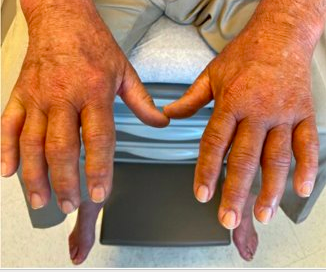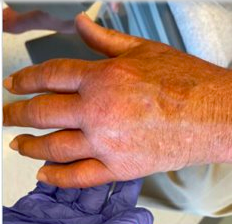Case Presentation: A 71-year-old male with a medical history of type 2 diabetes and hypothyroidism presented with six months duration of intermittent pain, swelling, numbness and tingling of his hands. He was previously diagnosed with carpal tunnel syndrome and had carpal tunnel release of his left wrist five months prior to presentation; however, the swelling in his left hand became significantly worse since his surgery. He completed a Methylprednisolone dose pack without any benefit. Acetaminophen helped somewhat with the pain. He endorsed diminished grip strength and morning stiffness lasting about 30 minutes. He denied sores in mouth or nose, rashes, photosensitivity, dry eyes, alopecia, Raynaud’s phenomenon, dysphagia, myalgia, pleurisy or hematuria. He denied a family history of autoimmune disease. He was employed as an accountant and denied tobacco, alcohol or recreational drug use. In the clinic, BP = 130/80 mm Hg, HR = 70 bpm, RR = 16 bpm, T = 97.3 F, SpO2 = 98% on room air, and BMI = 30.2 kg/m2. On physical exam he had synovitis in all proximal interphalangeal (PIP) joints and metacarpophalangeal (MCP) joints with pitting edema in both hands. Significant labs included c-reactive protein of 0.9 mg/dL (normal < 0.5 mg/dL) and uric acid of 7.7 mg/dL (normal 3.4-7.0 mg/dL). Sedimentation rate, anti-nuclear antibodies, DNA antibody, rheumatoid factor, anti-cyclic citrullinated peptide antibody, SCL-70 antibody, Sjogren’s antibody A and B, SM antibody and human leukocyte antigen-B27 (HLA-B27) were negative. Bilateral wrist x-rays were negative for erosions. He was treated with oral Prednisone 10 mg once daily with return to clinic in one week. Despite his elevated uric acid, he clinically fit the picture of Remitting Seronegative Symmetrical Synovitis with Pitting Edema (RS3PE), with excellent response to Prednisone.
Discussion: RS3PE was formerly considered a subset of Rheumatoid Arthritis (RA) but is now regarded as a distinct syndrome. It is described as “boxing glove hand” given the characteristic swelling and symmetrical polyarthritis with a dramatic onset of pitting edema over the hands. It is associated with elevated acute phase reactants, negative rheumatoid factor, and an excellent response to steroids. There have been reports that the disease is associated with HLA-B7 and HLA-A2 haplotypes and that vascular endothelial growth factor (VEGF) contributes to hypervascularity and vascular permeability, leading to synovitis and subcutaneous edema.
Conclusions: RS3PE is a rare clinical entity that is easily missed due to lack of knowledge. An early and prompt diagnosis is required, as proper treatment results in dramatic relief. Misdiagnosis results in more intensive and expensive therapy, as seen in this patient who had carpal tunnel release. RS3PE is associated with neoplasms, raising the suspicion of it being a paraneoplastic syndrome; thus, it is advisable to look also for malignancy in a patient with a diagnosis of RS3PE.


